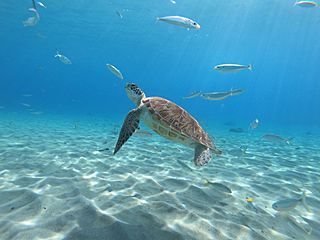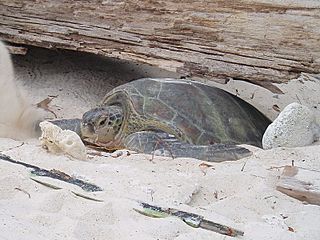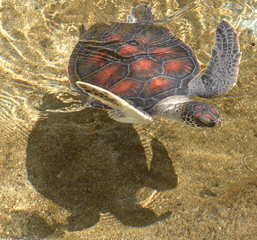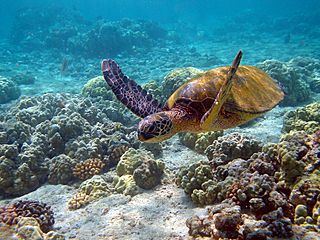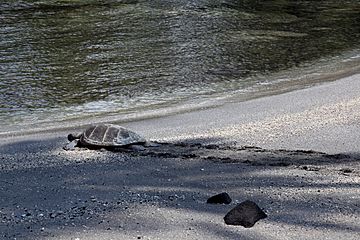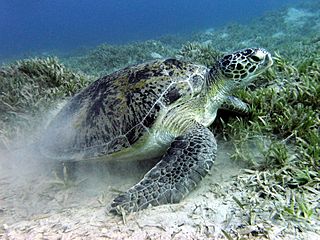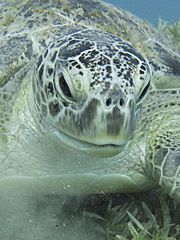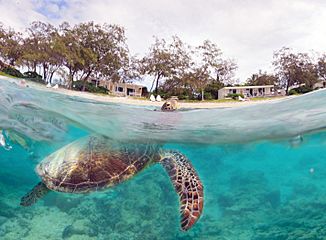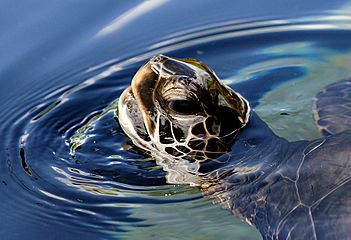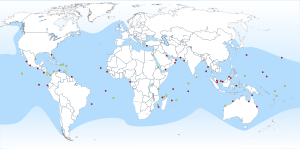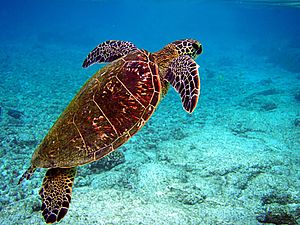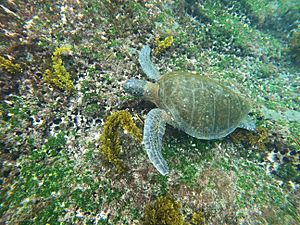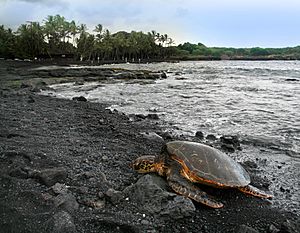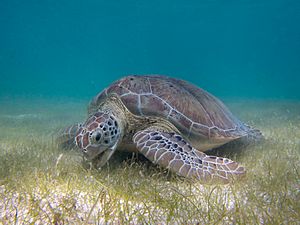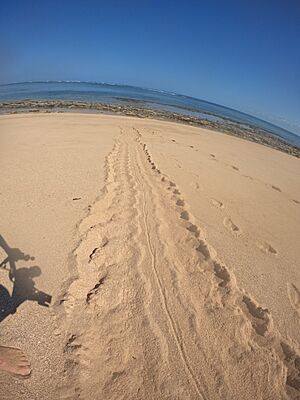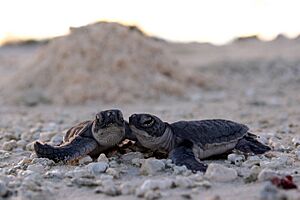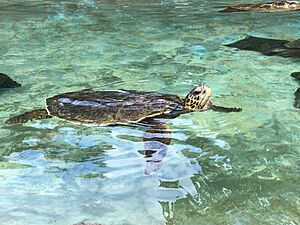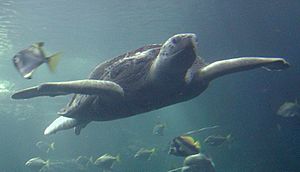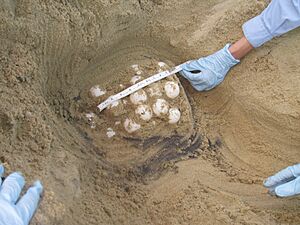Green sea turtle facts for kids
Quick facts for kids Green sea turtle |
|
|---|---|
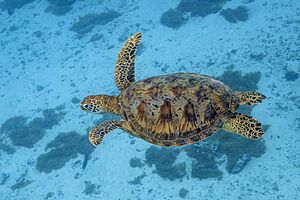 |
|
| Moorea, French Polynesia | |
| Conservation status | |
| Scientific classification | |
| Genus: |
Chelonia
|
| Species: |
mydas
|
| Synonyms | |
|
Species synonymy
Testudo mydas
Linnaeus, 1758 Testudo macropus Walbaum, 1782 (nomen illegitimum) Testudo viridis Schneider, 1783 Testudo japonica Thunberg, 1787 Testudo marina vulgaris Lacépède, 1788 Testudo viridisquamosa Lacépède, 1788 Testudo mydas macropus Suckow, 1798 Chelonia mydas — Brongniart, 1800 Testudo chloronotos Bechstein, 1800 Testudo cepediana Daudin, 1801 Testudo rugosa Daudin, 1801 Chelone mydas — Brongniart, 1805 Chelonia japonica — Schweigger, 1812 Chelonia virgata Schweigger, 1812 Caretta cepedii Merrem, 1820 Caretta esculenta Merrem, 1820 Caretta thunbergii Merrem, 1820 Caretta mydas — Fitzinger, 1826 Caretta virgata — Fitzinger, 1826 Chelonia lachrymata Cuvier, 1829 Chelonia maculosa Cuvier, 1829 Chelonia midas [sic] Wagler, 1830 (ex errore) Chelonia mydas var. japonica — Gray, 1831 Chelonia esculenta — Wiegmann & Ruthe, 1832 Chelonia bicarinata Lesson, 1834 Chelonia marmorata A.M.C. Duméril & Bibron, 1835 Chelonia (Chelonia) cepedeana [sic] Fitzinger, 1835 (ex errore) Chelonia viridis — Temminck & Schlegel, 1835 Mydas mydas — Cocteau, 1838 Mydasea mydas — Gervais, 1843 Euchelonia mydas — Tschudi, 1846 Megemys mydas — Gistel, 1848 Chelonia lacrymata [sic] Agassiz, 1857 (ex errore) Chelonia formosa Girard, 1858 Chelonia tenuis Girard, 1858 Euchelys macropus — Girard, 1858 Chelone macropus — Strauch, 1862 Chelone maculosa — Strauch, 1862 Chelone marmorata — Strauch, 1862 Chelone virgata — Strauch, 1862 Chelone viridis — Strauch, 1862 Chelonia albiventer Nardo, 1864 Thalassiochelys albiventer — Günther, 1865 Chelonia agassizii Bocourt, 1868 Mydas viridis — Gray, 1870 Chelone midas — Cope, 1871 Chelonia lata Philippi, 1887 Chelone mydas — Boulenger, 1889 Chelonia mydas mydas — Mertens & L. Müller, 1928 Caretta thunbergi [sic] H.M. Smith, 1931 (ex errore) |
|
The green sea turtle (Chelonia mydas) is a very large sea turtle. It is also known as the green turtle, black (sea) turtle, or Pacific green turtle. It is the only species in its genus, Chelonia.
These turtles live in warm tropical and subtropical oceans all over the world. You can find them in the Atlantic Ocean, Pacific Ocean, and Indian Ocean. They are called "green" turtles because of the green fat under their shell, not because their shell is green. This green fat comes from their diet of seagrass.
Green sea turtles have a flat body and big, paddle-like flippers for swimming. They are usually light-colored, but some in the eastern Pacific can be almost black. Unlike most other sea turtles, adult green sea turtles are mostly herbivores, meaning they eat plants. They love to eat seagrass in shallow lagoons. By biting off the tips of the seagrass, they actually help the grass stay healthy. Green sea turtles are the only sea turtles that eat only plants as adults, which makes them special. Their plant-based diet helps them grow very big, up to 300-350 pounds (136-159 kg)!
Like other sea turtles, green sea turtles travel long distances between where they eat and where they lay their eggs. Many islands are even called "Turtle Island" because these turtles nest there. Female turtles come onto beaches at night, dig nests, and lay their eggs. Later, the baby turtles hatch and rush into the water. Green sea turtles can live up to 90 years in the wild.
Sadly, Chelonia mydas is an endangered species. It is protected in most countries, meaning it is against the law to collect, harm, or kill them. Many places also protect their nesting beaches. However, human activities still threaten these turtles. They are sometimes hunted for food, and pollution harms them. Many turtles get caught in fishing nets by accident. Also, new buildings near beaches can destroy their nesting habitat.
Contents
About Green Sea Turtles
The green sea turtle belongs to a group of sea turtles called Cheloniini. Scientists have studied how green turtles are related to other sea turtles. For example, the plant-eating Chelonia (green turtle) is different from meat-eating turtles like the hawksbill sea turtle, loggerhead sea turtle, and ridley turtles.
The famous scientist Carl Linnaeus first described this species in 1758. He called it Testudo mydas. Later, another scientist named a Pacific population Chelonia agassizii, or the "black sea turtle." But scientists found that these "black sea turtles" were not truly a separate species. So, they are all now known as Chelonia mydas.
The common name "green sea turtle" comes from the greenish color of their fat, which is found between their organs and shell. This color comes from their diet of plants. Green turtles have many local names around the world. In Hawaii, they are called honu, and they are a symbol of good luck and long life.
-
A green sea turtle swimming over sand in Curaçao.
-
A female green sea turtle returning to the sea after nesting in Redang Island, Malaysia.
-
A green sea turtle near Marsa Alam, Egypt.
-
A close-up of a green sea turtle near Marsa Alam, Egypt.
-
A green sea turtle in Key West, US.
Physical Description
Green sea turtles look like typical sea turtles. They have a flat body, a short neck with a beaked head, and paddle-like arms for swimming. Adult green turtles can grow up to 5 feet (1.5 meters) long. They usually weigh between 150 and 420 pounds (68-190 kg). Their shell length is typically 31 to 44 inches (78-112 cm). They are the second largest sea turtle in the United States, after the leatherback sea turtle.
Some very large green sea turtles have weighed over 700 pounds (315 kg). The biggest known green sea turtle weighed 870 pounds (395 kg) and had a shell 60 inches (153 cm) long!
Green turtles have a few unique features. Their snout is short, and their beak is not hooked. They cannot pull their neck into their shell. The upper jaw has a jagged edge, and the lower jaw is strong and serrated. Their head has a single pair of scales in front. Their top shell (carapace) has five central plates and four pairs of side plates. Underneath, they have four pairs of plates between their belly shell (plastron) and their top shell. Adult green turtles have only one claw on each front flipper, unlike hawksbill turtles which have two.
The color of a green turtle's shell changes as it grows. Baby turtles have mostly black shells and light-colored bellies. Young turtles' shells turn dark brown to olive green. Adult shells can be entirely brown, or spotted and marbled with different patterns. Their belly shell is yellow. Their flippers are dark with yellow edges and often have a large dark brown spot.
Where Green Sea Turtles Live
Green sea turtles live in warm tropical and subtropical oceans worldwide. There are two main groups: the Atlantic and the eastern Pacific populations. Each group has its own special places for nesting and feeding. They also have different types of mitochondrial DNA, which shows they have been separated for a long time. This separation likely happened because the southern tips of South America and Africa blocked warm water paths.
Green sea turtles live near the coasts of over 140 countries. They have nesting sites in more than 80 countries. In the United States, you can find them along the Atlantic coast from Texas to Massachusetts. On the Pacific coast, they are found from southern California to Alaska. The largest groups in the U.S. are in Hawaii and Florida. Globally, big populations live in Australia's Great Barrier Reef and the Caribbean Sea.
Atlantic Population
You can find green sea turtles all over the Atlantic Ocean. While they prefer warm areas, they can also be found in cooler places. Some have been seen as far north as Canada and even near Denmark. Their southern range extends past the tip of Africa and into Argentina.
Major nesting sites in the Atlantic include islands in the Caribbean, the Atlantic coast of Florida in the United States, and the eastern coast of South America. Important isolated islands for nesting are in the North Atlantic.
In the Caribbean, key nesting spots are Aves Island, the United States Virgin Islands, Puerto Rico, the Dominican Republic, and Costa Rica. Tortuguero in Costa Rica is one of the most important nesting grounds in the Caribbean. Most green turtles in this region come from a few beaches in Tortuguero.
In the U.S., smaller nesting sites are in Georgia, North Carolina, and South Carolina. Florida's east coast has the largest nesting site in the U.S. Hutchinson Island is a very important nesting area. Florida often closes beaches during nesting season to protect the turtles. In 2015, over 37,000 green sea turtle nests were found in Florida, which was a record!
Important feeding areas in Florida include Indian River Lagoon, the Florida Keys, and Florida Bay. In South America, secluded beaches in Suriname and French Guiana are notable. In the South Atlantic, Ascension Island hosts 6,000–13,000 turtle nests.
Indo-Pacific Population
In the Pacific Ocean, green sea turtles range from southern Alaska to Chile in the east. In the western Pacific, they reach Japan and southern Russia, and as far south as New Zealand and islands near Tasmania. Many nesting grounds are found across the Pacific, including Mexico, the Hawaiian Islands, the South Pacific, northern Australia, and Southeast Asia. Major nesting colonies in the Indian Ocean are in India, Pakistan, and Sri Lanka.
Turtles are also found throughout the Indian Ocean. The east coast of Africa has nesting grounds, including islands around Madagascar.
Specific Nesting Areas
Nesting grounds are found along the Mexican coast. These turtles feed in seagrass areas in the Gulf of California. Hawaiian green turtles nest at the protected French Frigate Shoals, about 500 miles (800 km) west of the Hawaiian Islands.
In the Philippines, green turtles nest in the Turtle Islands alongside hawksbill turtles. In December 2007, a large turtle weighing 176 pounds (80 kg) was accidentally caught near Zamboanga City, Philippines. December is breeding season there.
An annual presence of green turtles is recorded in the Gulf of Panama, on Isla Parida. Local groups move some turtle nests to safer areas near Malena to help increase the turtle population.
Indonesia has nesting beaches, including one in the Meru Betiri National Reserve in East Java.
Off the coasts of Australia, the Great Barrier Reef has two genetically different groups of green turtles. Twenty small islands and cays in the reef are nesting sites. The most important is Raine Island. In the Torres Strait, there is a large nesting area on Bramble Cay. The Coral Sea also has very important nesting areas.
Major nesting sites are found on both sides of the Arabian Sea, in Oman and along the coast of Karachi, Pakistan. Beaches like Hawke's Bay and Sandspit are used by both green turtles and olive ridley sea turtles. Sandy beaches along Sindh and Balochistan are also nesting sites. Astola island, about 15 miles (25 km) off the Pakistani coast, is another nesting beach.
Galápagos Green Turtle
The green turtles in the Galápagos Islands have been known since the 17th century. For a long time, not much attention was paid to them because of all the research on the Galápagos giant tortoises. Only in the last 30 years have scientists studied their behaviors.
There has been a debate about whether these turtles are a separate species. They were once called Chelonia agassizii. But studies of their DNA show they are not genetically different enough to be a separate species. So, Chelonia agassizii is now considered just another name for Chelonia mydas. It is seen as a local type of green turtle found in the East Pacific.
The Galápagos green turtles look a bit different. They are smaller as adults and have much darker shells, bellies, and flippers. Their shell also curves more above their back flippers and is more dome-shaped. Adult males have very long tails. These differences led to the debate, but DNA evidence shows they are the same species.
Green Sea Turtle Habitat
Green sea turtles use different habitats during their lives. They lay their eggs on sandy beaches. Adult turtles spend most of their time in shallow, coastal waters where there are lots of seagrass beds. They often stay in bays, lagoons, and shallow areas with plenty of seagrass. Entire groups of turtles often travel between the same feeding and nesting spots.
Green sea turtles live in warm tropical to subtropical waters around the world. The ocean temperature limits where they can live; they avoid waters colder than 45-50 degrees Fahrenheit (7-10 degrees Celsius). Within their range, they usually stay near coastlines and islands. In these protected areas, their habitats include coral reefs, salt marshes, and seagrass beds. Coral reefs provide algae for them to eat and offer protection from predators and storms. Salt marshes and seagrass beds have lots of plants for them to feed on.
Young turtles spend their first five years in the open ocean. They are rarely seen during this time, as they swim in deep waters. Green sea turtles typically swim at speeds of 1.5-2 miles per hour (2.5-3 km/h).
Ecology and Behavior
Green turtles are one of the most studied sea turtle species. What we know about sea turtle behavior often comes from them. Their behavior changes a lot as they grow. When they first hatch, they are meat-eaters and live in the open ocean. But as they get older, they move closer to shore and become plant-eaters, grazing in seagrass meadows.
Diet
The diet of green turtles changes with age. Young turtles eat meat, but as they grow, they become omnivores (eating both plants and animals). Young sea turtles eat fish and their eggs, sea hare eggs, jellyfish, small invertebrates, and crustaceans. They also eat algae, seagrasses, and leaves.
As they mature, most adult green sea turtles become strict plant-eaters. Their body fat turns green because of all the plants they eat. Their jagged jaws help them chew green and red algae and seagrasses. They also eat wetland plants found in salt marshes. Green sea turtles grow slowly because their plant-based diet doesn't have a lot of nutrients.
Predators and Parasites
Only large sharks and humans hunt adult green sea turtles. Specifically, tiger sharks hunt adults in Hawaiian waters. Tiger sharks are the main predators of green turtles, preying on turtles of all sizes, especially near nesting beaches where turtles are more vulnerable.
Young turtles and new hatchlings have many more predators. These include crabs, small marine mammals, and shorebirds. Their eggs are also eaten by scavengers like red foxes and golden jackals.
Green sea turtles can get various parasites. Barnacles attach to their shells, and leeches attach to their flippers and skin, causing harm and blood loss. Tiny organisms like protozoans, cestodes, and nematodes can cause infections in their liver and intestines, leading to many turtle deaths.
The biggest disease threat is fibropapilloma. This disease causes tumors to grow on their scales, lungs, stomach, and kidneys, which can be deadly. It is caused by a herpesvirus spread by leeches that feed on green sea turtles.
Life Cycle and Reproduction
Green sea turtles travel long distances between where they eat and where they lay eggs. Some swim over 1,600 miles (2,600 km) to reach their nesting grounds. They breed on beaches in Southeast Asia, India, islands in the western Pacific, and Central America. Adult turtles often return to the exact beach where they hatched.
Female turtles usually mate every two to four years. Males, however, visit breeding areas every year to find mates. Mating seasons differ between populations. For most green turtles in the Caribbean, mating season is from June to September. In French Guiana, they nest from March to June. In tropical areas, green turtles nest all year, but some prefer certain times. In Pakistan, Indian Ocean turtles nest year-round, but mostly from July to December.
Sea turtles return to their birth beaches to lay eggs. This ensures they find a good environment for nesting. This includes a sandy beach, easy access to the ocean for hatchlings, the right temperature for eggs, and few predators. Over time, turtles have learned to return to places where their babies have successfully hatched for many generations. This ability to return home is called natal homing. Males also return to their birthplaces to find mates, as females born there also return to breed. This helps green sea turtles have more babies, which is why they travel thousands of miles.
Mating is similar to other sea turtles. Female turtles control the process. After mating in the water, the female crawls above the high tide line on the beach. She digs a hole 11-22 inches (28-56 cm) deep with her back flippers and lays her eggs. She then covers the hole. A female lays between 85 and 200 eggs in one nest, depending on her age. This takes about an hour to an hour and a half. After covering the nest, she returns to the sea. A female will do this 3 to 5 times in one season.
The eggs are round and white, about 1.8 inches (45 mm) wide. The baby turtles stay buried for days until they all hatch together at night. The temperature of the nest determines if the turtles will be male or female, usually around 20-40 days into incubation. Warmer nests (above 86 degrees Fahrenheit or 30 degrees Celsius) produce females, while cooler nests produce males. Eggs in the center of the nest tend to be warmer and produce females.
After 50 to 70 days, the eggs hatch at night. The hatchlings instinctively head straight for the water. This is the most dangerous time for them. Predators like gulls and crabs eat them as they walk. Many never make it to the ocean.
We don't know much about the early lives of newly hatched sea turtles. Young turtles spend three to five years in the open ocean before they move to their permanent shallow-water homes. It is thought that they take 20 to 50 years to become adults and reproduce. Green sea turtles can live up to 80 years in the wild. Only about 1% of hatchlings survive to become adults.
Each year on Ascension Island in the South Atlantic, female green turtles create 6,000 to 25,000 nests. These are some of the largest green turtles in the world, often over 3 feet (1 meter) long and weighing up to 660 pounds (300 kg).
Breathing and Sleep
Sea turtles spend almost all their lives underwater, but they must come up for air. They can quickly breathe out and breathe in to replace the air in their lungs. Their lungs are good at exchanging oxygen and preventing gases from getting trapped during deep dives. Sea turtle blood can carry oxygen well, even under the pressure of deep water.
During normal activity, green and loggerhead turtles dive for about four to five minutes. They then surface to breathe for only one to three seconds. Turtles can rest or sleep underwater for several hours. However, they hold their breath for shorter times when diving for food or escaping predators. Their ability to hold their breath is affected by how active or stressed they are. This is why turtles can quickly drown if caught in fishing nets. At night, adult turtles often wedge themselves under rocks or ledges in reefs to sleep and protect themselves from predators. Many green sea turtles return to the same sleeping spot night after night.
Green sea turtles have good eyesight, which is well-suited for life in the ocean. They can see many colors, especially violet to yellow light (wavelengths of 400 to 600 nanometers). They don't see many colors in the orange to red part of the light spectrum. On land, sea turtles are nearsighted because their eye lenses are shaped for seeing underwater.
Sea turtles do not have outer ears. They have only one ear bone, called the columella. Because of this, they can only hear low-frequency sounds, from 200 to 700 Hz. They can also detect sounds through vibrations in their head, backbone, and shell.
A turtle's nose has two openings that connect to the roof of its mouth. The lower part of the nasal passage has special sensory cells called the Jacobson's organ. Turtles can use this organ to smell by pumping water in and out of their nose.
Since green sea turtles travel long distances to breed, they have special ways to find their way. In the open ocean, they use wave directions, sunlight, and water temperatures to navigate. They also have an internal magnetic compass. They can sense Earth's magnetic field using tiny magnetic crystals in their brains. This helps them detect the strength of the magnetic field and find their way back to their nesting or feeding grounds.
Natal homing is when an animal returns to its birthplace to reproduce. All sea turtles and other animals like salmon do this. How turtles find their way back is amazing. Many scientists believe sea turtles use a process called imprinting. This is a special type of learning that happens when turtles first hatch. It allows them to remember their home beach.
There are two main ideas about how they do this. The first is the chemical imprinting idea. This says that turtles, like salmon, use their sense of smell to find their way home. But a problem with this idea is that some turtles travel thousands of miles, and smells might not travel that far.
The second idea is the geomagnetic one. This says that when a young turtle hatches, it remembers the magnetic field of its birth beach. This idea fits well with how sea turtles navigate using Earth's magnetic field.
To deal with losing heat in the water, sea turtles can send blood away from body parts that don't need as much oxygen to their heart, brain, and central nervous system. They also warm up by basking on sunny beaches and by moving their muscles. Basking turtles sometimes look like they are crying. This is because a gland behind their eye stores extra salt from seawater and then releases it through their eyes. In winter, turtles in colder areas might hibernate in the mud for a short time.
Special Features of Green Sea Turtles
Green sea turtles can swim up to 40 miles per hour (64 km/h), making them the fastest sea turtle! Male and female adult green sea turtles look different. Males have a longer tail that extends past their shell and longer claws on their front flippers.
The temperature of the nest determines when the eggs hatch and whether the babies will be male or female. Eggs hatch faster in warmer nests. Warm nesting sites (above 86 degrees Fahrenheit or 30 degrees Celsius) produce female turtles, while cooler nests produce males. Eggs in the center of the nest are usually warmer and produce females.
Green sea turtles are very important to their ecosystem. In seagrass beds, they eat only the tops of the seagrass, leaving the roots. This helps the seagrass beds stay healthy and grow. Healthy seagrass beds provide homes and food for many fish and crustaceans. On nesting beaches, the empty eggshells provide important nutrients for the ecosystem.
In coral reefs, green sea turtles have a special relationship with fish like the yellow tang. The yellow tang fish swim along with the turtle and eat algae, barnacles, and parasites from its shell and flippers. This helps the yellow tang get food and helps the turtle by cleaning its shell, which reduces drag and improves its health.
Importance to People
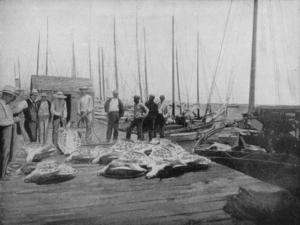
In the past, people used green turtle skin to make handbags, especially in Hawaii. Ancient Chinese people thought sea turtle meat was a special food. The fat, cartilage, and meat of green turtles were used to make turtle soup, which was popular in the 1800s.
In Java, Indonesia, sea turtle eggs were a popular food. In Bali, turtle meat was important for religious feasts. Bali imported turtles from other islands because its own supply ran low. The mostly Hindu people of Bali did not eat the eggs, but sold them to local Muslims.

Commercial farms, like the Cayman Turtle Farm in the West Indies, used to raise green turtles to sell their meat, oil, shells, and leather. The farm started with eggs from nests that were in danger. At one point, the farm had 100,000 turtles. When international rules stopped the trade of turtle products, the farm became a tourist attraction. It still cares for 11,000 turtles.
Sea turtles are a big part of the history and culture of the Cayman Islands. When Christopher Columbus discovered the islands in 1503, he named them "Las Tortugas" (The Turtles) because there were so many sea turtles. Early visitors came to the Cayman Islands to catch turtles for fresh meat during long sea trips.
The green turtle is a national symbol of the Cayman Islands. It is on their coat of arms and their national flag. A turtle is also the watermark on their money. A cartoon sea turtle called "Sir Turtle" is the mascot for their airline, Cayman Airways.
A rock carving (petroglyph) of a green sea turtle (or honu) can be found on the Big Island of Hawaii. This shows how important the honu has always been to Hawaiians. It might even date back to when the Hawaiian Islands were first settled. The turtle symbolizes a navigator who can always find his way home. This is like real green Hawaiian turtles, who swim hundreds of miles to lay eggs where they were born. Some Hawaiian legends say the honu were the first to guide the Polynesians to the Hawaiian Islands. Hawaiians respect the turtle and tell the legend of Kailua, a turtle who could turn into a girl and watch over children playing on Punaluʻu Beach.
Conservation Efforts
In recent years, sea turtles have moved from being hunted freely to being protected globally. Many countries also have their own protection laws. However, serious threats still exist. All green sea turtle populations are considered "threatened."
Threats to Green Sea Turtles
Humans cause both intentional and unintentional threats to green sea turtles. Intentional threats include continued hunting, poaching, and collecting eggs. More dangerous are unintentional threats like boats hitting turtles, fishing nets without special escape devices for turtles, pollution, and habitat destruction.
Chemical pollution can cause tumors in turtles. Waste from harbors near nesting sites can disturb them. Light pollution can confuse baby turtles, making them go the wrong way instead of towards the ocean. Tar balls from oil spills are often eaten by turtles, blocking their insides and causing swelling.
Habitat loss happens when humans build on nesting areas. Building near beaches, filling in land, and more tourism are examples of this. An infectious disease called fibropapillomatosis also causes tumors and kills many turtles. It is spread by a herpesvirus.
In the Southwestern Atlantic, invasive species like the rapa whelk can attach to young green turtles. This makes it harder for them to float and swim, and can cause serious injuries to their shells.
We don't know much about where Pacific green turtles find food. These areas are likely along the coast of Baja California, Mexico, and southern California. Here, turtles are at high risk of being accidentally caught by local fisheries. Shrimp trawlers in Mexico are a major cause of death for these turtles, and many deaths go unreported. The only known feeding area, San Diego Bay, is heavily polluted with metals and PCBs. These pollutants harm the ocean and can cause sickness and death in turtles.
Green turtles are also threatened by getting tangled in and eating plastic. A dead adult green turtle in San Diego Bay was found with fishing net packed in its throat. Also, global warming is affecting green turtle populations in Australia. Higher temperatures in the northern Great Barrier Reef region are causing more female turtles to hatch, which could lead to fewer males for breeding. Building new power stations can also raise local water temperatures, which is a threat.
Green sea turtles are the most commonly traded species along Java's south coast. They are sold whole, stuffed, or as "minyak bulus" (turtle oil).
The book The Green Turtle and Man by James J. Parsons was very important in starting the movement to save this species.
Global Conservation Efforts

The International Union for Conservation of Nature (IUCN) has listed green sea turtles as endangered many times. In 1982, they officially called it an endangered species. This listing continued in 1986, 1988, 1990, 1994, and 1996.
In 2004, the IUCN reclassified Chelonia mydas as endangered. This means wild populations face a high risk of extinction due to several factors. These include a likely population drop of more than 50% over the last ten years, based on estimates and hunting levels.
On May 3, 2007, Chelonia mydas was listed on Appendix I of the Convention on International Trade in Endangered Species (CITES). This means international trade in the species (including parts) is not allowed. The Zoological Society of London has also listed the green turtle as an EDGE species, meaning it is very unique and very endangered.
The Mediterranean population of green turtles is listed as critically endangered. The eastern Pacific, Hawaiian, and Southern California populations are listed as threatened. Specific Mexican populations are endangered. The Florida population is endangered. The World Wide Fund for Nature says populations in Pakistan are "rare and declining."
Since 1999, the Florida Aquarium has worked to help sea turtles. They have rescued and released many turtles. In 2019, they opened a new Sea Turtle Rehabilitation Center. They also started studying how micro-plastics affect the turtles they care for. In 2016, Florida put in place strong protection measures. It is now required to get special permission for any activities involving marine turtles in Florida.
In Hawaii, a state representative tried to remove the green turtle from protected status so Native Hawaiians could legally hunt them. However, the bill did not pass the U.S. Senate.
Country-Specific Initiatives
Besides global efforts, many countries have their own conservation plans.
The Indonesian island of Bali used to hunt turtles a lot. In 1999, Indonesia limited turtle trade and eating due to falling populations and a threat of tourist boycotts.
Many protected areas in the Philippines have important green sea turtle nesting and feeding sites. The Turtle Islands Wildlife Sanctuary is one of the most important nesting sites in Southeast Asia. Other important sites include El Nido-Taytay Management Resource Protected Area and Tubbataha Reefs Natural Park. The species is protected by law in the Philippines.
Ecotourism is helping in Sabah, Malaysia. The island of Pulau Selingan has a turtle hatchery. Staff move some eggs to the hatchery to protect them from predators. After about 60 days, the eggs hatch. Tourists can help release the baby turtles into the sea.
The Hawaiian green turtle population has recovered well and is now a focus of ecotourism. It has become a state mascot. Students from Hawaii Preparatory Academy have tagged thousands of turtles since the early 1990s.
In the United Kingdom, the species is protected by a Biodiversity Action Plan due to overhunting and pollution. The Pakistani branch of the World Wide Fund for Nature has been working to protect turtle nesting since the 1980s, but the population is still declining.
In the Atlantic, conservation efforts focus on Caribbean nesting sites. The Tortuguero nesting beaches in Costa Rica have had limits on egg collection since the 1950s. The Tortuguero National Park was created in 1976 partly to protect these nesting grounds. On Ascension Island, which has very important nesting beaches, there is an active conservation program. Karumbé has been watching young green turtles in Uruguay since 1999.
In Mozambique, there are many efforts to protect sea turtles. In the Primeiras e Segundas, WWF Mozambique has a turtle tagging and protection program. This area is vital for green turtles, including Ilha do Fogo and Celdeira Island, where nesting females have been tagged.
Cayman Turtle Farm in Grand Cayman is the first farm to have second-generation green sea turtles born and raised in captivity. Since 1968, the farm has released over 31,000 turtles into the wild. Each year, more captive-bred turtles are released into the Caribbean Sea. Turtles released from the farm as babies have started to return to nest on Grand Cayman as adults. On February 19, 2012, the farm released the first second-generation captive-bred green sea turtle with a satellite tracker. The farm also provides turtle meat to local people, which helps reduce the hunting of wild turtles. This has led to more turtles being seen around Grand Cayman and nesting on its beaches.
In the Pacific, green sea turtles nest on the motu (small islands) in the Funafuti Conservation Area in Tuvalu.
On Raine Island, up to 100,000 nesting females have been seen in one season. This island produces 90% of the region's green turtles. However, the hatching rate dropped in the 1990s. Thousands of females also died trying to climb sandy cliffs. The island's shape had changed, leading to more nests being flooded. Between 2011 and 2020, a project reshaped the island using heavy machinery. This made it easier for female turtles to climb and reduced nest flooding. Scientists use 3D modelling, satellite technology, and drones to monitor the turtles.
As of June 2020, "The Turtle Cooling Project" is studying how global warming affects northern green turtle breeding. They are looking at how higher temperatures are causing more female turtles to hatch. This project involves scientists from the World Wildlife Fund Australia, University of Queensland, Deakin University, and the Queensland Government. They are working around Raine Island, Heron Island, and Moulter Cay.
Genetics
The genome (all the genetic material) of Chelonia mydas was studied in 2013. This helped scientists understand how the turtle body developed and changed over time.
See also
 In Spanish: Tortuga verde para niños
In Spanish: Tortuga verde para niños



